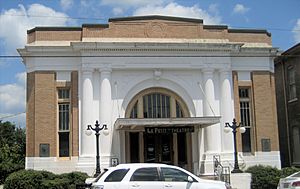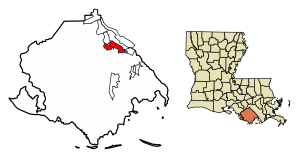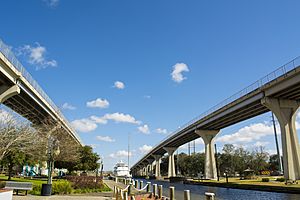Houma, Louisiana facts for kids
Quick facts for kids
Houma, Louisiana
|
|
|---|---|
| City of Houma | |

Former City Hall, now Le Petit Theatre
|
|

Location of Houma in Terrebonne Parish, Louisiana.
|
|
| Country | |
| State | |
| Parish | Terrebonne |
| Founded | 1834 |
| Incorporated | 1848 |
| Reincorporated | 1898 |
| Named for | Houma people |
| Parish seat | Terrebonne |
| Principal city | Houma–Bayou Cane–Thibodaux Metropolitan Statistical Area |
| Region | Acadiana South Louisiana |
| Government | |
| • Type | Government |
| • Body | Consolidated City-Parish |
| Area | |
| • City | 14.60 sq mi (37.80 km2) |
| • Land | 14.47 sq mi (37.47 km2) |
| • Water | 0.13 sq mi (0.33 km2) |
| Population
(2020)
|
|
| • City | 33,406 |
| • Density | 2,309.12/sq mi (891.55/km2) |
| • Metro | 208,178 |
| Time zone | UTC−6 (CST) |
| • Summer (DST) | UTC−5 (CDT) |
| ZIP code |
70360, 70363-64
|
| Area code | 985 |
| FIPS code | 22-36255 |
Houma (pronounced HOH-mə) is the biggest city in Terrebonne Parish, Louisiana. It is also the main city of the Houma–Bayou Cane–Thibodaux metropolitan area. This means it's a central hub for many nearby towns.
In 1984, the city's government joined with the parish government. Now, they work together as the Terrebonne Parish Consolidated Government. In 2020, about 33,406 people lived in Houma. Many areas next to Houma, like Bayou Cane, are often thought of as part of the city. But they are counted separately in official population numbers. If these areas were included, the total population would be over 60,000!
Contents
What's in a Name?
The city of Houma got its name from the Houma people, a Native American tribe. Many believe they are related to the Choctaw tribe. The United Houma Nation is recognized by the state of Louisiana.
A Look Back at Houma's History
Long before Europeans arrived, the Chitimacha and then the Houma Indians lived in this area. Houma was named after the Houma Indians who lived near Ouiski Point. When the United States bought Louisiana, the land claimed by the Houma Indians was not recognized.
The city of Houma was officially started in 1832. It became an incorporated city in 1848. In the years before the American Civil War, the area grew with many sugar cane plantations. These farms were built along rivers and bayous for easy water travel.
From the Past to Today
Sugar cane farming stayed important even after the Civil War and into the 1900s.
In 1984, the city and parish governments officially joined together. This made it easier to manage the area. In 2021, a very strong storm called Hurricane Ida hit Houma. It caused a lot of damage to the city.
Where is Houma?
Houma is located at 29°35′15″N 90°42′58″W / 29.58750°N 90.71611°W. It is about 10 feet (3 meters) above sea level. The city covers about 14.2 square miles (36.8 square kilometers). Most of this area is land, with a small part being water.
Houma's Weather
Houma has a warm and humid climate. Summers are hot and sticky, while winters are usually mild. This type of weather is called a humid subtropical climate.
| Climate data for Houma, Louisiana | |||||||||||||
|---|---|---|---|---|---|---|---|---|---|---|---|---|---|
| Month | Jan | Feb | Mar | Apr | May | Jun | Jul | Aug | Sep | Oct | Nov | Dec | Year |
| Record high °F (°C) | 88 (31) |
87 (31) |
90 (32) |
92 (33) |
99 (37) |
104 (40) |
102 (39) |
101 (38) |
100 (38) |
96 (36) |
91 (33) |
89 (32) |
104 (40) |
| Mean daily maximum °F (°C) | 67 (19) |
68 (20) |
74 (23) |
80 (27) |
86 (30) |
91 (33) |
91 (33) |
91 (33) |
88 (31) |
81 (27) |
73 (23) |
67 (19) |
80 (27) |
| Daily mean °F (°C) | 56 (13) |
57 (14) |
63 (17) |
69 (21) |
75 (24) |
80 (27) |
81 (27) |
81 (27) |
78 (26) |
69 (21) |
61 (16) |
56 (13) |
69 (21) |
| Mean daily minimum °F (°C) | 45 (7) |
47 (8) |
53 (12) |
59 (15) |
64 (18) |
70 (21) |
72 (22) |
72 (22) |
69 (21) |
58 (14) |
50 (10) |
46 (8) |
59 (15) |
| Record low °F (°C) | 14 (−10) |
5 (−15) |
25 (−4) |
28 (−2) |
42 (6) |
51 (11) |
58 (14) |
56 (13) |
43 (6) |
30 (−1) |
21 (−6) |
15 (−9) |
5 (−15) |
| Average precipitation inches (mm) | 4.1 (100) |
4.3 (110) |
4.4 (110) |
4.2 (110) |
4.2 (110) |
6.2 (160) |
8.5 (220) |
7.2 (180) |
6.3 (160) |
3.9 (99) |
3.8 (97) |
4.8 (120) |
61.9 (1,576) |
Who Lives in Houma?
| Historical population | |||
|---|---|---|---|
| Census | Pop. | %± | |
| 1860 | 429 | — | |
| 1870 | 593 | 38.2% | |
| 1880 | 1,084 | 82.8% | |
| 1890 | 1,280 | 18.1% | |
| 1900 | 3,212 | 150.9% | |
| 1910 | 5,024 | 56.4% | |
| 1920 | 5,160 | 2.7% | |
| 1930 | 6,531 | 26.6% | |
| 1940 | 9,052 | 38.6% | |
| 1950 | 11,505 | 27.1% | |
| 1960 | 22,561 | 96.1% | |
| 1970 | 30,922 | 37.1% | |
| 1980 | 32,602 | 5.4% | |
| 1990 | 30,495 | −6.5% | |
| 2000 | 32,393 | 6.2% | |
| 2010 | 33,727 | 4.1% | |
| 2020 | 33,406 | −1.0% | |
| U.S. Decennial Census | |||

| Race | Number | Percentage |
|---|---|---|
| White (not Hispanic) | 19,456 | 58.24% |
| Black or African American (not Hispanic) | 8,065 | 24.14% |
| Native American | 1,428 | 4.27% |
| Asian | 472 | 1.41% |
| Pacific Islander | 12 | 0.04% |
| Other/Mixed | 1,537 | 4.6% |
| Hispanic or Latino | 2,436 | 7.29% |
In 2020, there were 33,406 people living in Houma. They lived in 12,612 households, with 7,970 being families.
In 2019, the average age of people in Houma was 36.8 years old. About 75.9% of the population was 18 or older. About 8.1% were aged 5 or younger, and 14.6% were 65 or older. The average household income was $42,949. About 23.8% of the people lived at or below the poverty line.
Learning in Houma
The Terrebonne Parish School District runs the public schools in Houma and the parish. Houma is home to Terrebonne High School, which is the second-oldest high school in Louisiana. Other high schools in Terrebonne Parish include South Terrebonne High School, H.L. Bourgeois High School, Ellender Memorial High School, and Vandebilt Catholic High School.
Southdown High School was built in the mid-1900s. It was originally a separate school for Black students from 1946 to 1969. After that, schools became integrated, meaning students of all races could attend together.
Houma's Unique Culture
Houma and the areas around it have a rich mix of French, Native American, Cajun, African, and Creole history. French and Spanish settlers first came to the region. In the late 1700s, many Acadians (who later became known as Cajuns) moved here. The British had forced them out of Nova Scotia because they wouldn't promise loyalty to the British King. About 3,000 Acadians eventually settled in this part of Louisiana.
Over time, French, Spanish, Acadian, and Native American people mixed. This created the special Cajun culture. The swampy land around Houma made it quite isolated until the 1930s. This isolation helped the Cajun culture and French language stay strong here for a long time.
Traditional Cajun culture in Houma includes:
- The French language
- Delicious Cajun cuisine (food)
- Celebrating Catholic festivals like Mardi Gras
This unique culture is still alive today and brings many visitors to the area.
In the 1970s, many refugees from South Vietnam came to the U.S. after the Vietnam War. They settled in Southern Louisiana to work as shrimpers, just like they did in Vietnam. Many Vietnamese families in Houma still work in shrimping today.
Downtown Houma is a special historic district. It is listed on the National Register of Historic Places. You can take a walking tour and visit places like:
- The Bayou Terrebonne Waterlife Museum
- The Folklife Culture Center
- The Regional Military Museum
- Southdown Plantation
- The Houma-Terrebonne Civic Center
Many people in the communities around Houma still make their living from the Gulf of Mexico. They catch shrimp, oysters, crabs, and fish. Some also work in the oil industry and shipbuilding.
The Voice of the Wetlands Music Festival, started by musician Tab Benoit, happens every October in Houma.
News and Media
Houma has its own local newspaper called The Courier. It was started in 1878. Another local newspaper is the Houma Times, which is published weekly and updates its website daily.
The area's only local TV station is KFOL-CD, also known as HTV. It broadcasts local news and other shows. There's also a statewide TV network called LCN-TV that shows Louisiana's entertainment and culture.
You can also listen to several radio stations in the Houma-Thibodaux area:
Getting Around Houma
Houma has its own airport, Houma-Terrebonne Airport, located a few miles southeast of the city center.
Good Earth Transit is Houma's bus system. It has five main routes and serves the city and nearby areas, including small bayou communities and the city of Thibodaux.
Most people in Houma use cars to get around. Some of the main roads include:
- US Route 90 (which will become I-49 in the future)
- LA HWY 311
- Tunnel Boulevard (LA 3040)
- LA 24 (also known as West Park Avenue and Main Street)
- LA 182 (New Orleans Boulevard)
Famous People from Houma
- Tab Benoit: A blues musician.
- Brandon Jacobs: An NFL running back.
- Frank Lewis: A professional athlete.
- Elijah McGuire: An NFL running back.
- Quvenzhané Wallis: A young film actress, known for Beasts of the Southern Wild.
- Justin Williams (baseball): An MLB Outfielder.
- Tramon Williams: A professional athlete.
Sister Cities
Houma has special connections with cities in other countries, called "twin towns" or "sister cities":
 Cambrai, France
Cambrai, France Datça, Turkey
Datça, Turkey Bathurst, New Brunswick, Canada
Bathurst, New Brunswick, Canada
In 2012, Terrebonne Parish also started a partnership with Weihai, China, to help with economic development.
See also
 In Spanish: Houma (Luisiana) para niños
In Spanish: Houma (Luisiana) para niños



